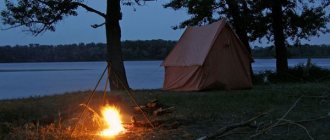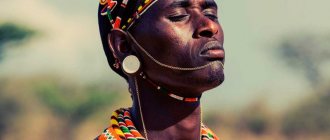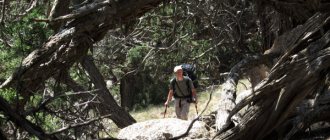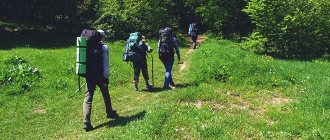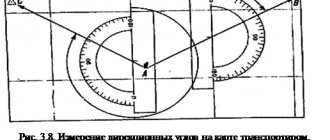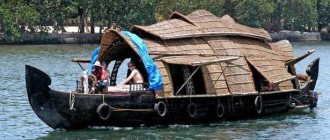If you are planning to go on a hike, you need to plan it, because you don’t go on extemporaneous hikes. Unless you're going on a weekend hike, and even then you have a rough idea of where you'll go and how your route will go.
How to develop a route for a tourist trip, whether on foot or by bicycle. Routes are compiled using the same algorithm.
Algorithm for drawing up a tourist route
- You need to select a travel area
- Selecting a difficulty category (we will omit this item and leave it to the professionals)
- Development of a “thread” of the route, places to visit (i.e., a section of the route, how and where we will go)
- Plan the approximate travel time (done in order to plan the number of products, equipment, etc.)
- Development of backup options and emergency departures from the route
- Preparation of drop-off and drop-off from the travel area (if planned)
- Drawing up estimates, layout of products, equipment, first aid kit
What to take with you on a day trip
Quite a lot has been written about what you need to take with you on multi-day hikes, but for some reason not enough attention is paid to preparing for a one-day outdoor recreation on a hike. And it’s completely in vain, because if you make a plan for the necessary things, a trip to the mountains, forest or just to the river will be much more pleasant.
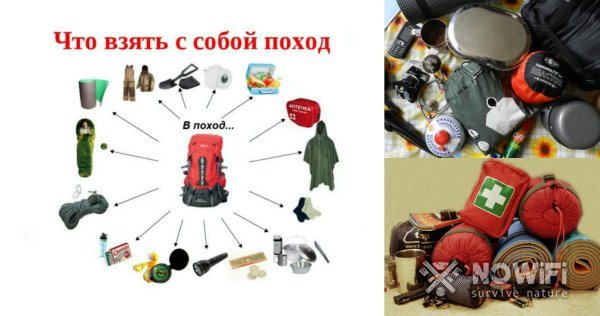
Figure 1. Equipment for a one-day outing can be minimal.
Since summer is a time for vacations and relaxation, it is better to make a list of things needed for a hike in advance. This will help you quickly pack up and hit the road whenever possible (Figure 1).
What routes are there?
There are several types of routes:
- Linear (i.e. we go from point A to point B)
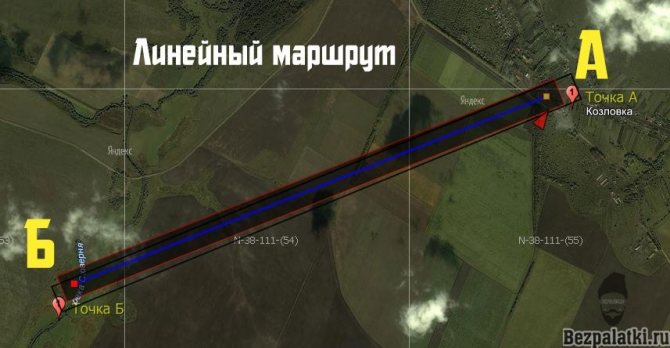
- Circular route (from where we came there and are returning, just in a different way)
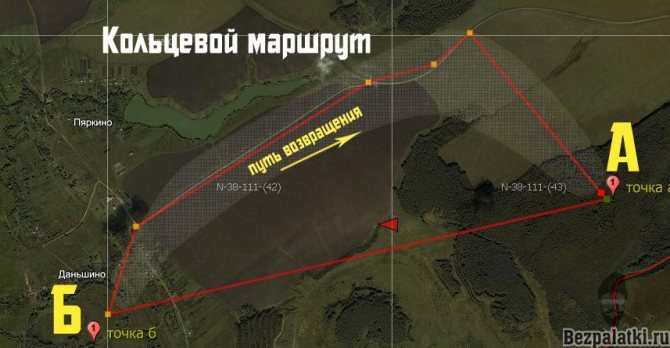
- Combined route (contains both linear and circular routes)

Development of a “thread” of the route, places to visit
Tourists call the route path a thread. That is, the entire distance from the beginning to the end of the path is a “thread”. You can develop a route using a map, or you can use a computer using the sasplanet or google earth programs. In these programs you can view a map of the route and build a route track (thread).
There are probably few people now who create a route track (thread) using a paper map, but there are some. Old school tourists and professionals prefer working with a paper map, even when planning a travel route.
I use the above-mentioned programs to develop a route, compile route tracks, save them there and upload them to the navigator. Because using the program you can view a map (both regular and satellite). This makes route planning much easier. You can immediately place waypoints on the map, measure the distance of the journey, and plan departure points. In short, I recommend it.
Also, when planning a route, you need to plan interesting places to visit (if required).

Break down your route by day
From the tourist dictionary:
Day break - a one-day rest stop during a hike
Detention - a forced stop on the route for one day or more
A spare day is an element of time resource that is allocated for a hike
An important point in route planning is the planned travel time. Time should always be planned with a slight “excess”.
The route is divided in such a way that each day begins and ends in a place suitable for overnight stay. The length of the day's trek largely depends on the nature of the terrain. You can walk up to 12 kilometers through the forest a day. I would advise not to put too much distance into your day. I plan on up to 10 kilometers of cross-country terrain; the hike should still be enjoyable...
Important! Don't expect a long distance on the first day. By the end of the hike, the distance traveled can be increased (backpacks have become lighter, there is less food, the walk is easier).
Naturally, it is not possible to accurately plan the time (the weather has turned bad, we were late for transport, etc.). But rough planning is necessary. To do this, you need to include extra days during the route.
Example route
We take into account: Hiking time + day + spare day
6 days of trekking + day + spare day = 8 days
Hiking from point A to point B, 60 kilometers long, along a dirt road. On average, you plan to walk 10 kilometers every day. That is, your hike will last 6 days (of course, you can plan a longer distance to travel per day). We add to six days a day (a day of rest, for example for washing, for a bath, visiting attractions, in case of bad weather) and one spare day.
Don’t forget to mark convenient places for days, overnight stays and bivouacs, as well as interesting places to visit.
↑ Equipment for a young tourist
↑ Shoes
Properly selected and well-tested equipment for a young tourist is of great importance on a hike.
Let's start with shoes.
“Shoes are as important to an infantryman as a horse is to a cavalryman,” said one general.
A careless choice of shoes for hiking or poor fit will cause your feet to become abraded even after a short walk. Shoes must be well-worn in and fit freely on the foot (it is recommended to have a margin in length - a tolerance of up to 2 cm). The toe of the boot or shoe should be wide enough so as not to squeeze your toes.
For a hike, you need durable, possibly soft, waterproof shoes. To do this, it must be lubricated with fat: blubber, fish oil or castor oil. Not suitable for waxing: it makes the skin hard and permeable to water. You should soak not only the top of the shoe, but also the sole and the cracks between the top and the sole.
The best backdrops are soft; otherwise they will put pressure on the heel and very soon cause severe pain in it.
For hiking, you need shoes with wide toes and low heels. You can't go far in high heels. The stride with high heels is always shorter. The position of the foot is inclined and the torso moves backward to maintain balance, and with this position the step is always shorter.
The sole is recommended to be thick or double. Otherwise, after several transitions you will have to walk on your own sole. You need to keep an eye on your heels and, if they are worn, immediately nail the heels. The heel should be padded with metal horseshoes or nails; At the same time, the shoes wear down less.
Boots with solid or leather soles are suitable. It's worse if the sole is rubber; her feet sweat. Then you can put a thick felt insole in your boot or wear woolen stockings. During short stops along the way, you should take off your shoes for at least one minute to air out your feet.
At a big rest stop, boots must be taken off for ventilation and drying. Do not dry them close to the fire, as the skin may crack. While your boots are drying, wear sports shoes. They are lightweight and will help your foot rest.
It is necessary to check that there are no nails protruding inside the boot, so that the lining that is carried through is not in folds.
It is good to walk on a dry, flat road in light boots. You cannot wear boots on bare feet. In this case, even in light shoes, it is easy to rub the heels and balls of the feet. Thick thread socks will be good for light shoes. But during long hikes, off-road, in rough shoes, you need to wear woolen stockings. It seems strange that it is recommended to wear woolen stockings in the summer, but an experienced tourist knows that the leg feels better (even cooler) in a woolen stocking. Wool stockings quickly absorb sweat and keep your skin dry. A wool stocking, in addition, is a good layer between the foot and the leather of the boot, smoothing out all the unevenness, roughness and folds.

If a tourist knows how to properly wrap foot wraps, he should wear them. The foot is perfectly protected with a thin, washed, soft footcloth (woolen or linen are the best).
Only those who have walked barefoot a lot before the hike and are well trained in this can go barefoot on a hike.
It is hopeless to acquire this skill during a hike - your legs will be knocked down at the first small transition. In addition, it is easy to bruise and injure your legs. But anyone who has the skill of walking barefoot will be happy to walk part of the way barefoot in some sections along a good road.
↑ Clothes
We recommend clothing that is durable, light, not easily soiled, but not dark in color. It should be free, not restricting movement. You should not tighten them with ties or sashes; it is better that the belts are replaced with armholes over the shoulders. The shirt should preferably have an open collar and must have sleeves. Only those who are already well tanned can wear a sleeveless T-shirt. You can't go hiking only in shorts.
It is necessary that clothes easily absorb sweat. Therefore, it is hygienic to wear a thin knitted T-shirt or (even better) a thin wool mesh. Otherwise, the sweat, having soaked the shirt, cools and wets the body. And this can cause a cold, especially in the wind, when sweat quickly evaporates from the surface of the body again. Girls wear light knitted leggings or satin panties; on top of them - a light woolen or satin skirt. For long hikes, trousers (ski suit) or satin bloomers are good. The best material for tourist clothing is wool, flannel is also good. These materials dry out quickly after rain. They are light and durable.
A hat should serve as protection from the sun and bad weather, and it should be used when this protection is needed. You should get used to walking in the summer without a hat and when traveling, at least part of the way, to go with your head open (avoiding, of course, the head from overheating by the sun's rays). A Panama hat is convenient for travel. The color of the hat should be white, or at least light, less absorbing of the sun's rays. Straw hats are beautiful, but they break quickly. Instead of a headdress, you can tie your head with a scarf (without covering your ears) or a towel (like a turban). But you still need to have a hat with you: it will come in handy in strong sun, bad weather, or on a cold evening.
↑ Packing things
Camping items are placed in a duffle bag-backpack. It is made from durable, dense material (canvas, tarpaulin, thick burlap). You need to choose a wider backpack. A wide backpack lightens the lower back, like a saddle, and the main burden of the load will fall on the sacrum. Your shoulders will feel lighter. The straps are made wide, preferably belt ones, and if made of fabric, then from a dense, durable material. Narrow straps twist and cut your shoulders.
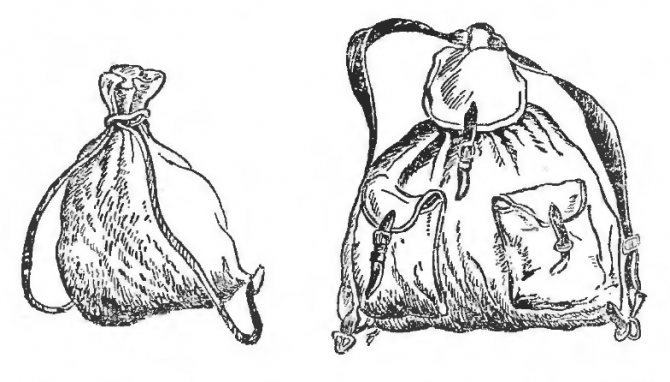
It's not difficult to make a backpack yourself. The picture shows how you can use any bag instead of a backpack.
You need to pack it in a backpack so that soft things lie flat and even on your back. Place heavier ones on the bottom. The center of gravity of a loaded backpack should be at the bottom, not at the top and to the side. Otherwise, the backpack will pull on your shoulders.
The length of the straps should be such that the backpack lies almost parallel to the back.
Carrying a backpack requires training, and if you didn’t have it before the hike, then a beginner may develop, out of habit, aching pain in his shoulders.
It is best to put the straps on the edge of the shoulder and do not cross them across the chest. This will constrict the chest.
It is advisable to have a cloth partition inside the backpack.
When packing things, they should be sorted: food in one compartment, everything else in the other.
_________
The weight of cargo allowed for a young tourist depends on the age and health of the participants in the hike (see table).
When distributing general equipment, it is necessary to take into account the training and strength of the participants in the hike, so that the more trained and strong take on more of the load.
Load standards for hiking in moderately rough terrain

Outline emergency and backup options
Fallback option
For example, you planned to go through the pass in one way, but on the way you suddenly encountered an obstacle (bad weather, an avalanche), you need a backup option for passing the path.
That is, the obstacle is more difficult to pass than you planned, and in this case you need a backup option. Having a backup option must be considered for each obstacle.
For example: You plan to walk through a forest clearing. What if the clearing is overgrown? Which path should you take in this case? If the pass cannot be passed (Avalanche). What will be the alternate route?
The path to overcome the obstacle should be as short as possible, but as easily passable as possible.
Emergency exit
An emergency exit is necessary in an emergency situation, when you need to get out to people as quickly as possible. Options for emergency derailment from the route are being explored for each populated area located near the route.
The more emergency exit points you plan, the better.
Points must meet the following criteria:
- The point must be close to or be a populated area (city, village with a medic, etc.),
- This may simply be a convenient place where a car (helicopter) can arrive to pick up the victim. Or a place from which you can quickly reach people.
As mentioned earlier, the more emergency departures from the route, the more you will protect yourself in the event of a force majeure situation.
Accordingly, the longer the route, the larger the vanishing point.
ENSURING PERSONAL SAFETY ON THE ROAD
INTRODUCTION
The modern lifestyle of the planet's population makes new demands on the formation of a culture of life safety, which can be defined as the level of development of man and society. This level is characterized by the significance of the task of ensuring life safety in the system of personal and social values, the prevalence of stereotypes of safe behavior in everyday life and in dangerous and emergency situations, the degree of protection from threats and dangers in all spheres of life.
In recent years, among the traditional and non-traditional forms of conducting a lesson on the basics of life safety in general education institutions, some new, active forms have begun to play a noticeable role. Testing occupies a special place among them. Testing in the course of the subject of life safety allows you to provide a more accurate and concise coverage of certain aspects of life safety, developing in students the relevant knowledge, skills and abilities.
The proposed test tasks will allow you to qualitatively assess the level of knowledge of students on safety and human protection in dangerous and emergency situations, as well as on the basics of medical knowledge and a healthy lifestyle. The manual includes tests with one correct option out of four answers. Test items on the basics of military service were published by the Legion publishing house in 2011.
These tests are designed to work with all textbooks on life safety for students in grades 10-11 of general education institutions, included in the Federal List of Educational Literature of the Ministry of Education and Science of the Russian Federation.
When completing multiple-choice assignments, circle the number of the correct answer on the exam paper.
Information from the publisher:
Klyuev Alexander Vladimirovich, teacher-organizer of life safety of school No. 106 in Zheleznogorsk, Krasnoyarsk Territory, associate professor of the department of “Life Safety” of the branch of the State Educational Institution of Higher Professional Education “Krasnoyarsk Pedagogical University named after V.P. Astafiev” in Zheleznogorsk, reserve colonel.
Savin Alexander Petrovich - head of the department of "Life Safety" of the branch of the State Educational Institution of Higher Professional Education "Krasnoyarsk Pedagogical University named after V.P. Astafiev" in Zheleznogorsk, candidate of pedagogical sciences, associate professor.
CLASS
Section 1. BASICS OF INTEGRATED SECURITY
AUTONOMOUS STAY OF HUMAN IN THE NATURAL ENVIRONMENT
Option #1
1. From the reasons listed below, select those that are the reasons for forced autonomous existence in natural conditions:
1) loss of some food, loss of compass
2) late registration of the tourist group before going on the route
3) loss of orientation on the terrain during a hike, vehicle accident in the natural environment
4) bad weather conditions along the route
2. The procedure for action in various emergency situations in the natural environment differs from each other and depends on the specific situation. From the following cases, select those when the team leader must decide to leave the scene of the accident:
1) the group cannot be detected by rescuers due to the dense vegetation surrounding it, there is an immediate threat to human life
2) the direction to the nearest populated area and its distance are unknown
3) the location of the incident is not precisely determined, the terrain is unfamiliar and difficult to pass
4) the exact location of the rescuers is unknown and the state of people’s health does not allow them to overcome the distance to the populated area
When going on a hike, you need to choose clothes. Which of the following requirements must it meet?
1) clothing should be loose and worn in several layers
2) clothes must be made of synthetic materials
3) clothing must be a single color or made of camouflage material
4) clothing must have reflective elements
4. Select from the proposed options the established requirements for the construction of temporary housing:
1) the place must be on the bank of a river or other body of water at water level
2) the place must be on a flat, elevated, ventilated area; there must be a source of water and sufficient fuel near the site
3) the place should be among dead wood, which can be used for a fire
4) there should be a road or a well-worn path near the site
5. Choose the most reliable method of water disinfection in the field:
1) cleaning through a sand and cloth filter
2) cleaning through a filter made of sand, cotton wool and cloth
3) boiling water
4) adding potassium permanganate to the water
Option No. 2
1. What main task is human activity aimed at solving under forced autonomy?
1) to return to people and normal life
2) to get new thrills
3) to organize active recreation in nature
4) to achieve new sporting achievements in orienteering
2. What is forbidden to do when making a fire?
1) use dead wood to make a fire
2) make a fire in peat bogs
3) use dry grass to start a fire
4) leave less than 3 people on duty at the fire
3. To choose the end point of a one-day nature hike, you must be guided by three main criteria. Find the error among the given answers:
1) the area of terrain chosen as the final point of the journey must be suitable for a large rest stop
2) the distance to the selected point on the ground should be no more than 10 km one way
3) the calculation of daylight hours must be sufficient to return to the starting point with a reserve of at least one hour
4) the end point of the journey must be located near the highway
4. Moving through a dry area, you become very thirsty. You have a full flask of water. What should I do?
1) drink often, but one sip at a time
2) save water and drink one cup a day
3) drink only if you are very thirsty, wet your mouth and drink one or two sips
4) quench your thirst by drinking half of the available water
5. While the group was moving in a thunderstorm, lightning struck nearby and one person fell. Upon examination, you noticed extensive red stripes on his body and a clear lack of signs of life. What are your actions?
1) immediately give the victim artificial respiration
2) bury it up to the neck in the ground to drain the electric current
3) rub the affected areas of the body with alcohol
4) do not touch the victim until he regains consciousness.
ENSURING PERSONAL SAFETY ON THE ROAD
Option #1
1. From the point of view of the Road Traffic Regulations, what are persons moving in wheelchairs without a motor called?
1) driver
2) passenger
3) pedestrian
4) traveler
2. Road users are:
1) persons directly involved in the movement process as a driver, pedestrian, passenger of a vehicle
2) these are persons directly involved in the movement process as a driver, pedestrian, and persons carrying out repair work on the roadway
3) people directly involved in the traffic process as a driver, passenger of a vehicle, and persons regulating traffic
4) citizens traveling in vehicles and on foot along the roadway, sidewalk and side of the road.
3. Specify the definition of the concept “road”:
1) roadway, sidewalks, roadsides
2) a strip of land for the movement of vehicles and pedestrians
3) a strip of land developed or adapted and used for the movement of vehicles or the surface of an artificial structure
4) a strip of land for the movement of cars, trams, trolleybuses, motorcycles and mopeds.
4. Where is it recommended to sit in the cabin of public transport if there are no free seats?
1) take an empty seat on the front platform of the vehicle
2) you need to try to stand in the center of the aisle, holding the handrail or special pendants with your hands
3) position yourself on the rear platform of the vehicle
4) it does not matter where the passenger will be if there are no seats
Drawing up estimates, layout of products, equipment, first aid kit
The last thing in developing a route is drawing up an estimate, laying out food, equipment and a tourist’s first aid kit. You can read about the tourist first aid kit here.
The estimate must include all costs for this route. This will not only allow you to calculate the cost of the trip, but will also ensure you don’t forget anything.
The correct layout of products is very important. Plan so that you are not hungry, have variety, but at the same time do not take too much, because... Carrying all this on yourself is not an easy task. Various tourist guides are very helpful with this, where you can find tables for calculating food norms per person and select the optimal diet.
The diet depends very much on the duration of the route. If your hike is designed for 1-3 days, then almost any product will do, but getting ready for a hike of 10 days is not so easy. I wrote about how to properly pack food for a hike here.
And remember, route planning should be taken as seriously as possible.
How to develop a hiking route
Features of drawing up walking routes
Planning a route is one of the most difficult tasks facing the leader of any hiking trip.
Good routes may or may not be taken. However, almost no one can ever pass a poorly conceived or insufficiently developed route, no matter how much effort is applied. It is extremely important when developing walking routes to avoid even minor mistakes, since a mistake can lead to many unpleasant consequences, even an accident. Hiking routes can be classified into the following categories:
- By timing:
- One-day.
Multi-day.
- By difficulty level:
- Hikes of low difficulty categories.
Hikes of high difficulty categories.
When developing each of the listed types of route, its own rules and tricks are applied, which are created to simplify the life of tourists on a hike. Before creating a route of any complexity, you need to decide on its purpose and objectives. If you do not determine them at the beginning of the route, later in the hike, clashes will inevitably arise, which will be caused by different opinions of the participants. Typically, trek leaders use one of the following two strategies:
Finished works on a similar topic
- Coursework Development of a hiking route 450 rub.
- Abstract Development of a hiking route 260 rub.
- Test work Development of a hiking route 190 rub.
Receive completed work or specialist advice on your educational project Find out the cost
- The goals and objectives of the hike are determined personally by the leader, and then participants are recruited who agree with them.
- The leaders complete the group, and then discuss with it the goals and objectives of the trip.
The first option is most suitable for small trips, where significant variations in goals and objectives are simply impossible. In addition, the first option is used in tourist clubs, where it is possible to select participants according to the goals and objectives of the trip. Also, these categories of hikes are used by inexperienced, novice groups under the supervision of an experienced leader. On such a route, the leader is usually a monopoly commander who alone makes decisions on all issues.
The second option is used for categories of trips where there is a limited choice of participants. The formation of a hiking group begins with a discussion of goals and objectives with the participants. The discussion can be done one by one or with everyone together. The leader in this case takes the position not of a commander, but of a senior comrade. On the route, he does not use authoritarian management methods; participants are closer to democracy in their desire to discuss decisions made.
Too lazy to read?
Ask a question to the experts and get an answer within 15 minutes!
Ask a Question

Figure 1. Development of a hiking route. Author24 - online exchange of student work

